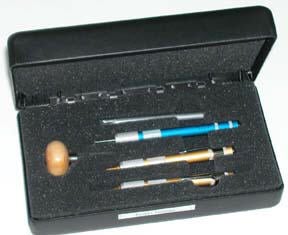Channel Setting Tools Designed For Wax
Stone-in-place casting is growing in practice with manufacturers and retail manufacturing operations taking advantage of these labor saving techniques. Stone-in-place casting requires gemstones be properly set in the wax model prior to casting. The most often utilized style of setting for this procedure is channel for round, baguette and princess cut gemstones..
3 Minute Read
This article introduces a new kit of hand-held channel setting tools used for detail work and channel setting stones on wax patterns.
Stone-in-place casting is growing in practice with manufacturers and retail manufacturing operations taking advantage of these labor saving techniques. Stone-in-place casting requires gemstones be properly set in the wax model prior to casting. The most often utilized style of setting for this procedure is channel for round, baguette and princess cut gemstones.
"Ready-to-Cast" Kit
Though less time consuming than channel setting stones in metal, the process of setting in wax is no less precise. The success of the cast piece is greatly dependent upon the careful preparation of the wax models for stone placement. For this process, Euro Tool Inc., a tool and equipment distributor has introduced a new kit of tools. The kit's named "Ready-Cast" and contains 5 precision quality hand-held tools that are designed to perform the basic functions for channel setting stones and general detail work on wax patterns prior to casting. Here's what it looks like:
Here's a closer look at how the kit is used:
This procedure works best for injected wax patterns that will be steam de-waxed. Carving wax is not used since it is not suitable for steam de-waxing. For the highest quality finished product, Ready-Cast's inventor prefers using a mixture of 50% Kerr Aqua and Blue Plastowax injection wax. He also reports using the kit to precut bearings into wax patterns prior to casting and setting the gemstones in the resulting cast products.
I found the tools in the Ready-Cast kit to be invaluable in the precision carving and finishing of wax models in general. The versatile shapes allow for sharp detail and clean-up in tight areas, producing finer castings and saving countless hours in metal finishing while lowering metal waste
You assume all responsibility and risk for the use of the safety resources available on or through this web page. The International Gem Society LLC does not assume any liability for the materials, information and opinions provided on, or available through, this web page. No advice or information provided by this website shall create any warranty. Reliance on such advice, information or the content of this web page is solely at your own risk, including without limitation any safety guidelines, resources or precautions, or any other information related to safety that may be available on or through this web page. The International Gem Society LLC disclaims any liability for injury, death or damages resulting from the use thereof.
The All-In-One Jewelry Making Solution At Your Fingertips
When you join the Ganoksin community, you get the tools you need to take your work to the next level.
Trusted Jewelry Making Information & Techniques
Sign up to receive the latest articles, techniques, and inspirations with our free newsletter.



